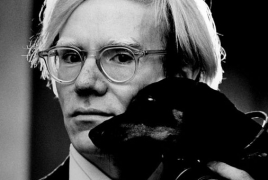Brandhorst Museum features “Warholmania in Munich” exhibit June 23, 2015 - 10:34 AMT PanARMENIAN.Net - Yes!Yes!Yes! Warholmania in Munich’ is a collaboration between the Museum Brandhorst and Filmfest München, featuring the painterly and cinematic work of Andy Warhol. In the sheer prolificacy of his creative output, Warhol’s legacy extends far beyond the realms of painting and film, and permeates an array of artistic and social areas. At various stages in his career he was a commercial artist, book illustrator, music producer; he founded a lifestyle magazine, ‘Interview’, still in circulation today, and launched his own TV show in the 1970s (well before MTV), with which he managed to capture the spirit of punk and new wave. As a result, Warhol ended up simultaneously becoming the darling of high art and mass taste, auctions and subculture. This exhibition and the accompanying programme of events lift the veil on the entire spectrum of Andy Warhol’s work, which has permanently altered our understanding of art, Art Daily reports. For the first time in its history, the Museum Brandhorst is presenting its entire collection of works by Andy Warhol in one go to mark ‘Yes!Yes!Yes! Warholmania in Munich’. With well over 100 works, the Museum Brandhorst boasts one of the most important Warhol collections in the world. In a series of rooms arranged both chronologically and by theme, the exhibition traces the key developments in his work. Starting with drawings and book illustrations from the 1950s and ending in the 1980s with his late work in diverse media, ‘Yes!Yes!Yes! Warholmania in Munich’ is retrospective in character. Warhol’s early drawings, which are shaped by his experience as a commercial artist, are presented alongside a selection of artist books from the same period, made in his capacity as a budding fine artist rather than a commercial one. Warhol’s ‘Liz’ (1964) and ‘Marilyn’ (1967) and other iconic images of the 1960s reveal his lifelong fascination with the glitter and glamour of the celebrity cult – but also its dark underbelly. His fascination for the latter can be inferred by the timing of the painting’s creation: he only decided to make his first ‘Marilyn’, for example, after she had committed suicide. This aspect of his work comes to the fore in the ‘Death and Disaster’ series, of which the Museum Brandhorst has an outstanding example in ‘Mustard Race Riot’ (1963). Media images of the race riots in Birmingham, Alabama were arranged in sequence on the monochrome canvas. Warhol revolutionized the medium of painting by using images culled from advertising and magazines as subjects for his paintings. The pivotal moment in this development was Warhol’s pioneering use of the silkscreen printing process in the early 1960s, which profoundly undermined the hitherto clear distinction between high art and commercial art, not to mention the question of original versus copy. Ara Aivazian said Azerbaijan continues the traditions of Turkey after seizing territories and forced Armenians out. The creative crew of the Public TV had chosen 13-year-old Malena as a participant of this year's contest. She called on others to also suspend their accounts over the companies’ failure to tackle hate speech. Penderecki was known for his film scores, including for William Friedkin’s “The Exorcist”, Stanley Kubrick’s “The Shining”. Partner news |